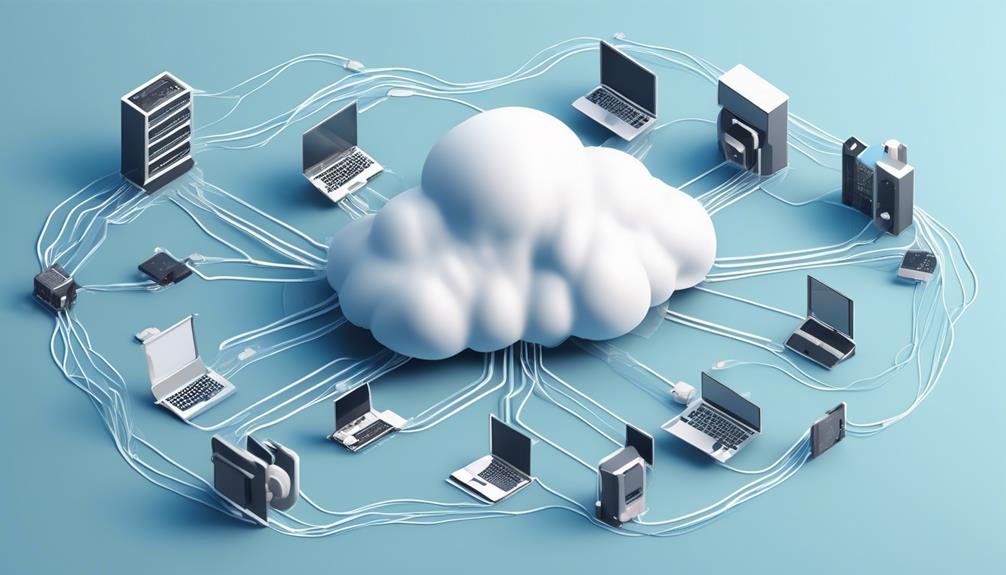As you peer into the intricacies of cloud computing applications, it’s akin to unraveling a complex web of interconnected components. The question arises: are cloud computing applications truly distributed systems?
The answer might not be as straightforward as you think. As you delve into this discussion, you’ll uncover the fundamental connections between cloud computing and distributed systems, shedding light on how they intertwine and diverge.
Stay tuned to unveil the intricate relationship between these two seemingly distinct yet interconnected realms.
Key Takeaways
- Cloud computing applications can be considered as distributed systems, as they involve the distribution of tasks across multiple computers located in different locations.
- Distributed cloud computing offers benefits such as enhanced scalability, fault tolerance, and low latency, making it ideal for large-scale projects and big data processing.
- The implementation of cloud computing faces challenges related to security, reliability, cost management, and network latency.
- Scalability, flexibility, fault tolerance, and resource utilization are key characteristics of distributed systems that are leveraged in cloud computing applications.
Cloud Computing and Distributed Systems Relationship

In the realm of cloud computing, the relationship with distributed systems is crucial for optimizing performance and expanding capabilities across various locations.
Distributed cloud computing extends the reach of traditional cloud computing by splitting tasks across multiple computers at different geographical locations, resulting in faster task completion. This approach leverages the network of resources, software, and hardware across various data centers to enhance scalability, fault tolerance, and low latency, making it ideal for large-scale projects and big data processing.
The synergy between cloud computing and distributed systems facilitates remote network access to hardware and software, while also enabling efficient and reliable distributed computing. This network of multiple computers working together enhances the overall performance and reliability of cloud computing applications. Additionally, edge and fog computing, as extensions of distributed cloud computing, further improve the collection and processing of data in close proximity to the point of generation, utilizing edge devices for computation, storage, and communication.
TIBCO’s distributed cloud computing solutions exemplify the benefits of this relationship, offering unified monitoring capabilities and enhanced communication between distributed systems.
Key Characteristics of Distributed Systems
Distributed systems, comprising multiple autonomous computers, facilitate parallel processing by distributing tasks among connected computers. In the context of cloud computing, distributed systems play a crucial role in enabling distributed computing across multiple systems.
One key characteristic of distributed systems is resource sharing, where a shared pool of resources is accessed by the connected computers. This resource sharing enhances efficiency and allows for more effective utilization of computing resources.
Additionally, distributed systems exhibit platform independence, enabling them to operate across diverse hardware and software environments. This characteristic is particularly significant in the realm of cloud computing, where flexibility and adaptability are essential.
Moreover, distributed systems offer economies of scale, as they can efficiently handle large workloads and scale resources based on demand. These key characteristics make distributed systems well-suited for cloud computing applications, as they align with the requirements of scalability, flexibility, and efficient resource utilization.
Challenges in Cloud Computing Implementation

Navigating the implementation challenges of cloud computing demands careful consideration of security, reliability, cost management, network latency, and implementation complexity.
When delving into the world of cloud computing, you’ll face several hurdles, including:
- Security Concerns: Ensuring comprehensive security measures across the entire network to mitigate risks of data breaches and unauthorized access in distributed cloud systems.
- Reliability and Availability: Balancing performance demand and ensuring high availability across distributed cloud systems, especially during downtime in one or more locations.
- Cost Management and Optimization: Managing and optimizing costs associated with distributed cloud computing, ensuring initial investment aligns with long-term benefits and scalability.
- Network Latency and Internet Dependency: Addressing challenges related to network latency and dependency on internet connectivity for distributed cloud systems by designing the system to run on multiple nodes simultaneously.
These challenges highlight the complexity of implementing distributed cloud computing, emphasizing the need for careful planning, expertise in distributed computing technologies, and the integration of multiple systems and networks. This makes the initial setup and configuration time-consuming.
Scalability and Flexibility in Cloud Computing
When considering the scalability and flexibility of cloud computing, it’s essential to understand the dynamic nature of resource allocation and workload management.
Cloud computing offers a shared pool of configurable computing resources that can be rapidly provisioned and released with minimal management effort. Scalability in cloud computing allows for the seamless addition of machines to handle increased loads, without any limit to the number of machines that can be added. This ensures that the system can adapt to varying workloads, providing the necessary resources to handle spikes in demand.
Additionally, flexibility in cloud computing enables machines to operate at full capacity during high loads and be taken offline during low workloads, optimizing resource allocation.
Distributed cloud computing systems also enable edge computing, which brings computation and data storage closer to the location where it’s needed, reducing latency and improving performance for users. Furthermore, the use of remote procedure calls and distributed computing makes cloud systems more fault-tolerant and reliable, with no impact on work in case of downtime and higher performance demand on other centers.
This distributed approach also proves to be cost-effective, leveraging economies of scale and reducing operational costs through resource sharing, making it more budget-friendly than large-scale centralized systems.
In the era of big data, the scalability and flexibility of cloud computing are crucial for meeting the dynamic and evolving demands of modern computing.
Fault Tolerance and Reliability in Distributed Systems

Ensuring fault tolerance and reliability in distributed systems is critical for maintaining uninterrupted operation and data integrity.
In the context of distributed computing and cloud computing, achieving fault tolerance and reliability involves implementing specific techniques and strategies. Here’s what you need to know:
- Redundancy: Distributed systems achieve fault tolerance by duplicating tasks among multiple nodes, ensuring continuity even if some nodes fail.
- Replication: Replicating data across multiple nodes helps maintain reliability by ensuring consistency and availability, even in the event of node failures.
- Consensus algorithms: These algorithms play a crucial role in ensuring reliability by facilitating agreement among nodes on the state of the system, even in the presence of faults or network partitions.
- Data consistency: Ensuring consistency and correctness of data is essential for reliability in distributed systems, and techniques such as versioning and distributed transactions help maintain data integrity.
Security Concerns in Distributed Cloud Computing
You should be aware of the data protection challenges, access control issues, and privacy and compliance concerns in distributed cloud computing.
These areas pose significant security risks that require your attention and proactive measures to mitigate.
Understanding and addressing these points is crucial for safeguarding your data and ensuring the integrity of your distributed cloud computing environment.
Data Protection Challenges
Data protection challenges in distributed cloud computing stem from the complex nature of data replication and the need for robust security measures across multiple locations and devices. Several key concerns arise when it comes to data protection challenges in distributed cloud computing. These concerns include:
- Ensuring secure sharing of resources in a distributed computing system
- Implementing robust security measures for remote methods of data access
- Managing data protection in both public and private cloud environments
- Ensuring that the network performs stringent security protocols to safeguard data
These challenges underscore the critical importance of maintaining stringent security measures to protect data in distributed cloud computing systems.
Access Control Issues
Addressing access control issues in distributed cloud computing requires robust authentication mechanisms and centralized management of user identities.
With resources distributed across multiple locations, ensuring consistent access control policies is vital. Implementing strong encryption, authentication, and authorization mechanisms is necessary to mitigate data security risks.
Centralized yet flexible identity management solutions are crucial for managing user identities and authentication in distributed cloud environments. Additionally, meeting regulatory compliance and governance requirements across diverse geographic locations poses a significant challenge.
Comprehensive monitoring and auditing capabilities must be in place to detect and respond to security threats. Ultimately, maintaining visibility into access patterns, user activities, and data movement is essential for enforcing security policies in distributed cloud computing.
Privacy and Compliance
Ensuring compliance with data protection regulations in distributed cloud computing requires robust security protocols and encryption methods for secure data transmission between components. To address privacy and compliance concerns, consider implementing the following measures:
- Data Protection Regulations: Comply with regulations such as GDPR, HIPAA, and CCPA for handling sensitive data.
- Secure Data Transmission: Implement security protocols and encryption methods to ensure data integrity and confidentiality.
- Access Control and Authentication: Employ strong mechanisms to prevent unauthorized access to cloud resources.
- Audit Trails and Logging: Maintain comprehensive records of user activities and system events for security and privacy auditing.
Addressing these aspects is crucial in navigating the complex landscape of privacy and compliance within distributed cloud computing.
Frequently Asked Questions
Is Cloud Computing a Distributed System?
Cloud computing is indeed a distributed system. It involves resource allocation across a network, scalability challenges, data partitioning, fault tolerance, load balancing, consistency models, security concerns, and performance optimization for efficient operations.
What Type of System Is Cloud Computing Considered?
Cloud computing is considered a distributed system, utilizing network infrastructure and virtualization technology for resource allocation. It offers scalability solutions, remote access, data security, and performance optimization, making it an efficient and versatile platform.
What Is an Example of a Distributed System Application?
Distributed cloud computing applications, like intelligent transport and caching for video services, showcase scalability challenges, fault tolerance, data consistency, load balancing, network latency, replication strategies, consensus algorithms, partition tolerance, and communication protocols.
Is Cloud Computing a Specialized Form of Distributed?
Yes, cloud computing is a specialized form of distributed systems. It tackles scalability challenges, data distribution, resource allocation, fault tolerance, network latency, load balancing, data replication, and security concerns efficiently.
Conclusion
So, are cloud computing applications considered distributed systems?
Yes, they are. Cloud computing shares the key characteristics of distributed systems, such as decentralized communication and task delegation. It also faces similar challenges, like scalability and security concerns.
However, cloud computing offers the benefit of easy access to resources over the internet, making it a convenient and efficient form of distributed system for users.
